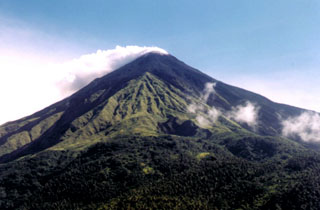Report on Karangetang (Indonesia) — 27 May-2 June 2009
Smithsonian Institution / US Geological Survey
Weekly Volcanic Activity Report, 27 May-2 June 2009
Managing Editor: Sally Sennert.
Please cite this report as:
Global Volcanism Program, 2009. Report on Karangetang (Indonesia) (Sennert, S, ed.). Weekly Volcanic Activity Report, 27 May-2 June 2009. Smithsonian Institution and US Geological Survey.
Karangetang
Indonesia
2.781°N, 125.407°E; summit elev. 1797 m
All times are local (unless otherwise noted)
CVGHM reported that seismicity from Karangetang increased during 30-31 May and tremor was detected. On 30 May, diffuse white plumes rose 10-50 m high and incandescence was seen at the crater. On 31 May, white emissions from Utama Crater in the N part of the summit region rose 100 m. Incandescent material traveled as far as 2.3 km, mostly down the S flank. Ash plumes that rose 25-700 m were accompanied by thunderous sounds. The Alert Level was raised to 4, the highest level on a scale of 1-4. People were advised not to go within a 3-km-radius of the active area. According to a news article, over 350 people evacuated the area.
Geological Summary. Karangetang (Api Siau) volcano lies at the northern end of the island of Siau, about 125 km NNE of the NE-most point of Sulawesi. The stratovolcano contains five summit craters along a N-S line. It is one of Indonesia's most active volcanoes, with more than 40 eruptions recorded since 1675 and many additional small eruptions that were not documented (Neumann van Padang, 1951). Twentieth-century eruptions have included frequent explosive activity sometimes accompanied by pyroclastic flows and lahars. Lava dome growth has occurred in the summit craters; collapse of lava flow fronts have produced pyroclastic flows.
Sources: Pusat Vulkanologi dan Mitigasi Bencana Geologi (PVMBG, also known as CVGHM), People's Daily Online (China)

